News
Interview with Caroline Fraser
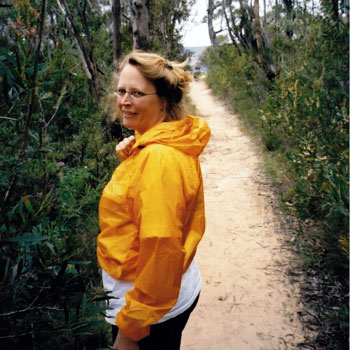 Image credit: Hal Espen
Image credit: Hal EspenIn your book, "Rewilding the World: Dispatches from the Conservation Revolution," you said, rewilding, which involves applying conservation and ecological restoration work to a "scale previously unimagined" is now the primary method for designing, protecting and restoring protected areas. You mentioned the important role of cores, carnivores and corridors in this work. Why these?
It was actually a biologist who came up with this definition. The biologist who was working on the definition, Michael Soule, someone I talk about in my book, was trying to think of ways to make these concepts friendly to a general audience, who are not biologists. He was inventive in latching onto terms like "rewilding." With this three-part formula for rewilding-- cores, corridors and carnivores-- he was trying to create a catchy phrase that people would remember, but it's based on science.
In the last 25-30 years, biologists have figured out that a lot of the parks that we have created since the nineteenth century are just not big enough to protect the wildlife that's within them. For a lot of reasons, we need to start enlarging those protected areas -- that is basically the definition of "cores." We need big, core areas-- big protected areas-- and we need corridors to try and connect those areas.
If you look at a map of North America, and the only things on that map are the protected areas, parks like Yellowstone, Glacier and so forth, you can see how very small they are in relation to the land mass and the wider landscape. You can also see how far apart they are from each other. Small "islands" of land and their isolation from each other are bad for biodiversity and sustaining species over time.
The third element is the carnivores, and they've added another category to that which they call "keystone species." The keystone species, which include animals like beavers, which act essentially like landscape architects, are very important in the ecosystem. Over the last 20-30 years, scientists have learned that if you take those out of the ecosystem, the whole system can start collapsing and some bizarre things will happen. Basically their goal is to try and revivify our protected areas by making them bigger, connecting those protected areas, and teaching people how to live with carnivores and keystone species in a way that is more sustainable. In fact, most species and endangered species live in areas that are outside of parks and protected areas. So we have to make some changes in our lifestyles, our way of living, in order to sustain the ecosystems that we rely on.
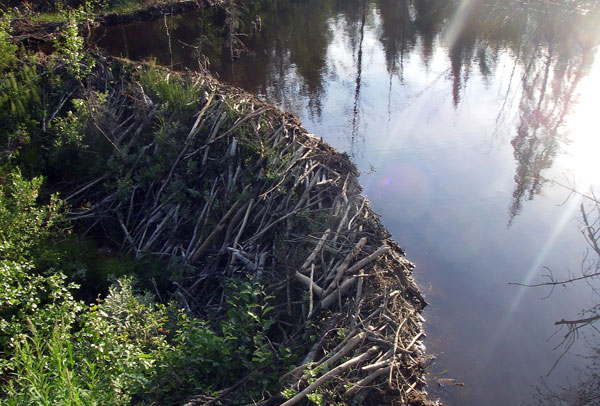 Large European beaver dam, Sweden. Image credit: Lars Falkdalen Lindahl / GNU - Wikipedia
Large European beaver dam, Sweden. Image credit: Lars Falkdalen Lindahl / GNU - Wikipedia
Protected areas have grown from 3 percent of the world's surface in the 1960s to over 12 percent today. This seems like a huge achievement, but you say many are just paper parks, particularly the transnational ones. How can you tell a successful park from a paper one?
I've been to a number of parks in Africa and in Asia, and one good way to tell a paper park is when you drive up to a park or a protected area, and there's nobody there. There's nobody there working for the park, there's nobody there to collect a fee to enter the park, there's nobody there guarding it. You can also tell from looking at the resources that are allocated to the park. Many developing countries don't have money to spend on their parks, so many have been virtually emptied of wildlife. Such countries may have a system of parks, but they have no way of protecting them. This is particularly true of marine protected areas, and I just saw the other day that the Philippines now have some 400 marine protected areas, but only 10 percent of those are achieving the goals they have set for conservation. You can can imagine how difficult and expensive it is to effectively patrol a marine protected area. It's also very difficult in some cases, in the very large parks in Africa, to hire enough people to patrol and manage them. A lot of these parks have no real management structure. They don't have people who are working to figure out what are the best ways to handle the wildlife, to protect the wildlife, and that's a huge problem. We've done a lot of good over the past 40 years in setting aside land on paper, but now we have to figure out how to protect those protected areas.
You said the first major rewilding project was the Yellowstone to Yukon Conservation Initiative (Y2Y), which aims to create a single wildlife corridor that connects isolated parks, national forests, and large, roadless areas, creating space for wolves, grizzlies and other species in the process. The project also led to investments in wildlife bridges and underpasses to enable migration and reduce roadkill. Why has this project been so revolutionary? What have been the successes and failures with this project so far?
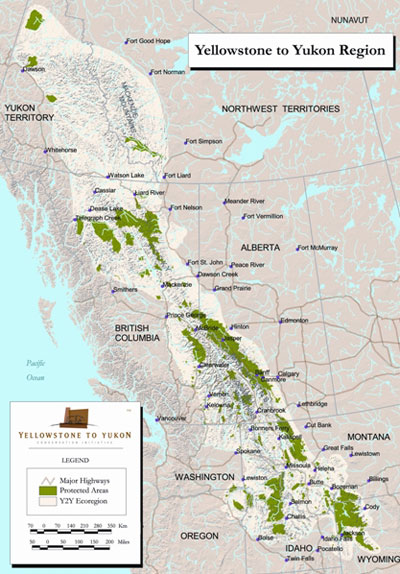 Yellowstone to Yukon Initiative (Y2Y) / Y2Y
Yellowstone to Yukon Initiative (Y2Y) / Y2Y
Y2Y was one of the first projects to get off the ground, and some of the people who were instrumental in creating the definition of rewilding worked on it at the very beginning. The major success Y2Y has had does involve these wildlife bridges and underpasses, which were not an original idea. They've been used in other places in the world for decades. In Europe, many of the highways and railroads that were designed in the mountainous areas of the Alps utilize these kind of structures. But what was revolutionary about Y2Y is that they brought that to North America, particularly to Canada and the U.S., in a way that was looking at the entire landscape for the first time, and that was revolutionary.
Before, everybody had just been focused on their own little patch-- their own little park or protected area, or their own community. But in this project, people stepped back and took a very large view of the entire Rocky Mountain corridor, beginning way up in Canada and coming all the way down through the United States. They began looking at important questions: What do we need to do to keep these areas open for wildlife to migrate and disperse? That was revolutionary for conservationists, to think on that scale, on a landscape scale. That has been hugely influential in North America in terms of conservation planning.
Where I think that the project has been less successful is in tackling some of the issues of reaching the public with these ideas. I don't think anybody in particular is to blame for that. It's partially a function of the political climate that we find ourselves in. Environmentalism, for good or ill, has been branded as a liberal topic in this country, and people have a hard time getting past that. For instance, in Spokane, Washington, they voted on whether they would accept the Y2Y plan, and embrace it as a community and use it as part of their landscape planning. They voted against that. There was a lot of anger and hostility expressed toward the project in that community. So there are real hurdles in getting the message out.
A number of major wildlife parks exist across or in between countries. Transnational and peace parks have grown over the years, reaching almost 200 in 2005. Peace parks, which have received support from the international community, are set up as a buffer between states in conflict. In another case, the lack of peace actually created a rich and varied interstate ecosystem between North and South Korea. In this case, minefields helped ensure the rich ecosystem was preserved. What are the opportunities and challenges in conserving and even rewilding when working across or in between borders?
This is an issue that goes to some of the problems that I was talking about in the previous question, which is that a lot of conservation right now is being handled or implemented by groups like Y2Y, which are non-governmental organizations (NGOs), essentially nonprofit, charitable groups. This is fine, but the problem with it is that there just isn't enough funding, and the funding is coming from private parties and not from the government. You were asking before about the growth in the percent of protected areas but that not enough of them are actually protected. That's a huge issue for governments to tackle, and I think that we need to start shifting our priorities to have governments being involved in the planning, implementing, and funding of these projects. If you don't, the money is spread too thin on the ground, and there also isn't coordinated planning at the level that there needs to be.
This is a huge issue with transnational and peace parks, because these are being planned at the government level, and yet again, we don't have enough funding to make these things happen in a lot of cases. Some of the really big projects that I talk about in southern Africa, for instance, are just getting off the ground, but developing countries are growing very impatient with the lack of funding from countries in the developed world, because they very much need that in order to get these things off the ground in any meaningful way. Peace parks and trans-boundary parks are going to be hugely useful in terms of planning for things like watersheds and fresh water protection and production, because this affects almost every country on most continents. Rivers cross borders. Wetlands cross borders.
Given the facts of climate change, given that the climate is changing and the supply of fresh water is being affected, neighboring countries are going to have to work together. So countries like Namibia, South Africa, Zambia, Botswana, and Angola, who are some of the partners in these trans-boundary parks, are really going to need to get together and start looking at how the watersheds are managed, how they can be protected from too much water being drawn off or from pollution being introduced into the system. Water sources are dwindling, and if governments get together and negotiate those things now, they may be able to avoid the hot conflicts that they've just managed to solve in the region. They're just coming out a period of devastating civil war, and they certainly don't want to go back to that. But water issues have the potential to cause conflict unless they are dealt with. Trans-boundary parks offer an opportunity for countries to work together to preserve their water resources.
A community river project on the Tana River in Kenya failed because, as one local biologist noted, "conservation is about managing people. It's not about managing wildlife." You argue that big, bureaucratic, top-down conservation projects often fail because they don't empower local communities. What approaches work for getting communities to take a lead in rewilding efforts? What are the sustainable economic models that can help maintain rewilding over the long-term?
The gentleman also said conservation projects are very, very tricky and that's an understatement. In the early 1990's, a lot of the projects that were rapidly being put into place by the World Bank and the U.N. and some conservation organizations were often crudely designed, and they didn't involve local people in a meaningful way. Sometimes they just handed out large sums of money to people who weren't set up to deal with that. So money was distributed in an inequitable way that caused problems in the community. Now, I think they're getting the hang of figuring out how to design projects in such a way that the local people can take charge of them. That's a big factor in the success or failure of these projects.
A lot of this involves what in U.N. speak is called"capacity building." You have to have people in the community who are trained and educated in how to design and run these projects. One case that is phenomenally interesting and successful is Namibia, where they wrote conservation into the constitution, one of the only examples of that in the world. Namibia has very successfully developed conservancy programs in which the villages or the communities themselves are running the programs and benefiting from them. This means people are completely invested in the projects. It's not just a situation where an outside organization or people from other countries are coming in and telling them what to do; they're actually designing these things and running them themselves. So they are able to benefit from the wildlife by selling hunting licenses, or by building and running ecotourism lodges. The conservancies that offer significant ownership of the project to communities seem to work the best. There are also examples of private organizations, private landowners, that develop something like this. In Kenya, the Lewa Wildlife Conservancy -- which is quite famous, and justly so, for running a private rhino reserve -- has offered services and support to their neighbors. They have invited neighboring Masai and Samburu people to create their own conservancies and ecotourism businesses in a collaborative program called the Northern Rangelands Trust. The NRT has greatly expanded the area under effective conservation management in that region. That's another very sucessful model.
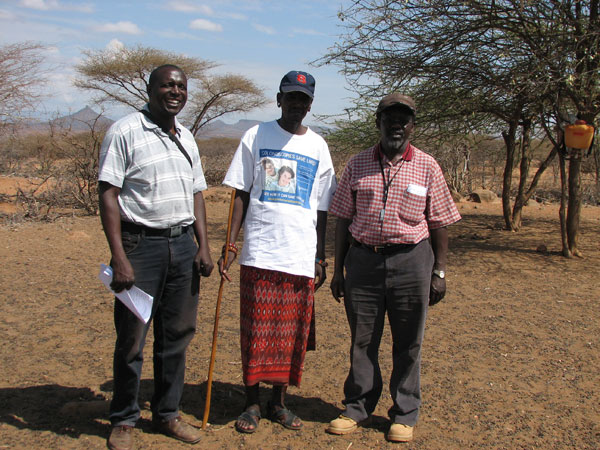 Northern Rangelands Trust, an enlarged protected area created by local communities of Maasai and Samburu north of the Lewa Wildlife Conservancy. The people in the photo, from left to right, are Dr. Sam Andanje (a Kenyan biologist), Keward (Sammy), Lekalkuli (the headman of one of the NRT conservancies, and Dr. William Ogara (a Kenyan biologist). They're conferring about problems caused in these areas by predators (lion, leopard, hyena) and discussing ways to improve fencing and protection of livestock. / Caroline Fraser
Northern Rangelands Trust, an enlarged protected area created by local communities of Maasai and Samburu north of the Lewa Wildlife Conservancy. The people in the photo, from left to right, are Dr. Sam Andanje (a Kenyan biologist), Keward (Sammy), Lekalkuli (the headman of one of the NRT conservancies, and Dr. William Ogara (a Kenyan biologist). They're conferring about problems caused in these areas by predators (lion, leopard, hyena) and discussing ways to improve fencing and protection of livestock. / Caroline Fraser
The Freshkills example is interesting, although I think it's probably too soon to say whether they've navigated all the potential pitfalls, because that project, as I understand it, is one that's going to be under development for many years, indeed, decades to come. Freshkills is also kind of an extreme example, and I chose it for that, because it is, of course, the restoration of a landfill. What will be interesting to watch with Freshkills is how well they work with other organizations focused on the larger ecosystem, the Hudson River itself, and some of the areas around it. There is, of course, a larger project underway to clean up the pollution in the Hudson and restore some of the fish populations there. But the larger question of how you figure out what you're working toward is a tremendously knotty or difficult one for landscape architects and ecological restoration.
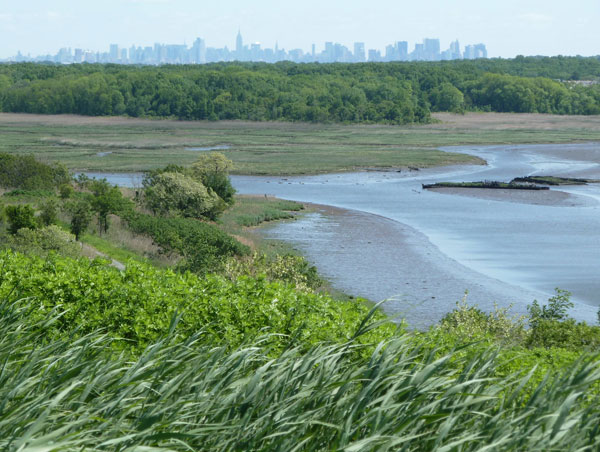 Freshkills Park, New York City. Image credit: James Corner Field Operations
Freshkills Park, New York City. Image credit: James Corner Field Operations
Clearly, you don't want to set a goal that is far too ambitious. I talk a little bit about some biologists who are interested in the Pleistocene rewilding idea in North America. They're discussiong the notion of replacing species that were lost ten thousand years ago when people first came over the land bridge from Siberia and wiped out a lot of the native species here, like the mammoth. There are very exotic plans to bring in elephants, cheetahs, or lions from Africa to replace the species that were wiped out, and restore the American prairie ecosystem. I think many people are pretty uncomfortable, if not downright enraged by those kinds of ideas. Restorationists are much more practical than that in looking at exactly what they're facing in terms of what has been the damage to the landscape and figuring out, "Okay, what exactly was here before? What can we work toward?"
A good example of that is the project in Wisconsin that Aldo Leopold was involved with: the Curtis Prairie site. That's a project that illustrates all the difficulty that restorationists face with invasive species. They also face the problem of keeping restoration intact once it has been partially restored. Some of the examples I give from Washington State are important in this regard. It's really key to think about how a restoration project fits into a larger ecosystem and how many resources will be available to work with over time. You have to think about how the project connects to the larger whole, and if you don't think about those things, then you can find yourself, as they did in Washington State, in Seattle, with the restoration of Lake Washington, moving some of those problems down the line and adding to other environmental problems. You really have to think big and long-term when you're doing these projects.
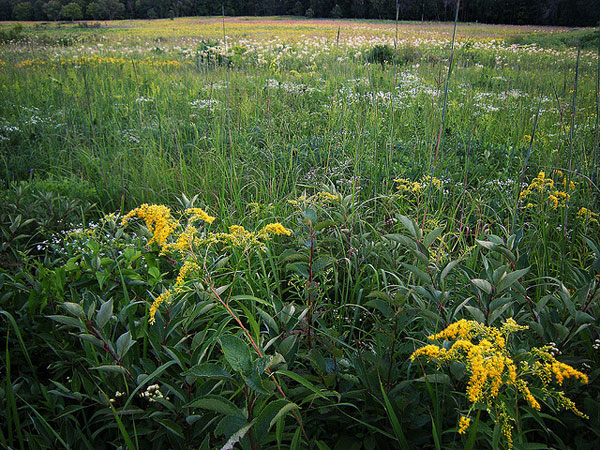 Curtis Prairie. Image credit: Madison Guy / Flickr
Curtis Prairie. Image credit: Madison Guy / Flickr
Y2Y was one of the first projects to get off the ground, and some of the people who were instrumental in creating the definition of rewilding worked on it at the very beginning. The major success Y2Y has had does involve these wildlife bridges and underpasses, which were not an original idea. They've been used in other places in the world for decades. In Europe, many of the highways and railroads that were designed in the mountainous areas of the Alps utilize these kind of structures. But what was revolutionary about Y2Y is that they brought that to North America, particularly to Canada and the U.S., in a way that was looking at the entire landscape for the first time, and that was revolutionary.
Before, everybody had just been focused on their own little patch-- their own little park or protected area, or their own community. But in this project, people stepped back and took a very large view of the entire Rocky Mountain corridor, beginning way up in Canada and coming all the way down through the United States. They began looking at important questions: What do we need to do to keep these areas open for wildlife to migrate and disperse? That was revolutionary for conservationists, to think on that scale, on a landscape scale. That has been hugely influential in North America in terms of conservation planning.
Where I think that the project has been less successful is in tackling some of the issues of reaching the public with these ideas. I don't think anybody in particular is to blame for that. It's partially a function of the political climate that we find ourselves in. Environmentalism, for good or ill, has been branded as a liberal topic in this country, and people have a hard time getting past that. For instance, in Spokane, Washington, they voted on whether they would accept the Y2Y plan, and embrace it as a community and use it as part of their landscape planning. They voted against that. There was a lot of anger and hostility expressed toward the project in that community. So there are real hurdles in getting the message out.
A number of major wildlife parks exist across or in between countries. Transnational and peace parks have grown over the years, reaching almost 200 in 2005. Peace parks, which have received support from the international community, are set up as a buffer between states in conflict. In another case, the lack of peace actually created a rich and varied interstate ecosystem between North and South Korea. In this case, minefields helped ensure the rich ecosystem was preserved. What are the opportunities and challenges in conserving and even rewilding when working across or in between borders?
This is an issue that goes to some of the problems that I was talking about in the previous question, which is that a lot of conservation right now is being handled or implemented by groups like Y2Y, which are non-governmental organizations (NGOs), essentially nonprofit, charitable groups. This is fine, but the problem with it is that there just isn't enough funding, and the funding is coming from private parties and not from the government. You were asking before about the growth in the percent of protected areas but that not enough of them are actually protected. That's a huge issue for governments to tackle, and I think that we need to start shifting our priorities to have governments being involved in the planning, implementing, and funding of these projects. If you don't, the money is spread too thin on the ground, and there also isn't coordinated planning at the level that there needs to be.
This is a huge issue with transnational and peace parks, because these are being planned at the government level, and yet again, we don't have enough funding to make these things happen in a lot of cases. Some of the really big projects that I talk about in southern Africa, for instance, are just getting off the ground, but developing countries are growing very impatient with the lack of funding from countries in the developed world, because they very much need that in order to get these things off the ground in any meaningful way. Peace parks and trans-boundary parks are going to be hugely useful in terms of planning for things like watersheds and fresh water protection and production, because this affects almost every country on most continents. Rivers cross borders. Wetlands cross borders.
Given the facts of climate change, given that the climate is changing and the supply of fresh water is being affected, neighboring countries are going to have to work together. So countries like Namibia, South Africa, Zambia, Botswana, and Angola, who are some of the partners in these trans-boundary parks, are really going to need to get together and start looking at how the watersheds are managed, how they can be protected from too much water being drawn off or from pollution being introduced into the system. Water sources are dwindling, and if governments get together and negotiate those things now, they may be able to avoid the hot conflicts that they've just managed to solve in the region. They're just coming out a period of devastating civil war, and they certainly don't want to go back to that. But water issues have the potential to cause conflict unless they are dealt with. Trans-boundary parks offer an opportunity for countries to work together to preserve their water resources.
A community river project on the Tana River in Kenya failed because, as one local biologist noted, "conservation is about managing people. It's not about managing wildlife." You argue that big, bureaucratic, top-down conservation projects often fail because they don't empower local communities. What approaches work for getting communities to take a lead in rewilding efforts? What are the sustainable economic models that can help maintain rewilding over the long-term?
The gentleman also said conservation projects are very, very tricky and that's an understatement. In the early 1990's, a lot of the projects that were rapidly being put into place by the World Bank and the U.N. and some conservation organizations were often crudely designed, and they didn't involve local people in a meaningful way. Sometimes they just handed out large sums of money to people who weren't set up to deal with that. So money was distributed in an inequitable way that caused problems in the community. Now, I think they're getting the hang of figuring out how to design projects in such a way that the local people can take charge of them. That's a big factor in the success or failure of these projects.
A lot of this involves what in U.N. speak is called"capacity building." You have to have people in the community who are trained and educated in how to design and run these projects. One case that is phenomenally interesting and successful is Namibia, where they wrote conservation into the constitution, one of the only examples of that in the world. Namibia has very successfully developed conservancy programs in which the villages or the communities themselves are running the programs and benefiting from them. This means people are completely invested in the projects. It's not just a situation where an outside organization or people from other countries are coming in and telling them what to do; they're actually designing these things and running them themselves. So they are able to benefit from the wildlife by selling hunting licenses, or by building and running ecotourism lodges. The conservancies that offer significant ownership of the project to communities seem to work the best. There are also examples of private organizations, private landowners, that develop something like this. In Kenya, the Lewa Wildlife Conservancy -- which is quite famous, and justly so, for running a private rhino reserve -- has offered services and support to their neighbors. They have invited neighboring Masai and Samburu people to create their own conservancies and ecotourism businesses in a collaborative program called the Northern Rangelands Trust. The NRT has greatly expanded the area under effective conservation management in that region. That's another very sucessful model.
Lastly, you conclude the world needs "smarter, more efficient rewilding." Worldwide total conservation spending is now around 10 billion, "mostly in the developed world where it's least needed." Instead you call for better leadership at the global and local levels. What role can landscape architects and planning who are ready to partner with policymakers, landowners, and scientists play in restoring ecosystems and help rewild the world?
I just got back recently from Nagoya, Japan, where the negotiations on the Convention on Biological Diversity were taking place. That was enormously instructive in terms of how global leadership functions when it comes to conservation. This is the only treaty in the world that is designed to protect biodiversity, and so it is a global planning tool, if you will. The Convention on Biological Diversity (CBD) sets targets for conservation. In fact, one of their stated goals was to increase the percentage of protected areas to 12 percent, which you mentioned earlier. That came out of the treaty. One of their big efforts now is to try to "mainstream" conservation into countries' budgets and governance, which will move conservation to the forefront of governments' priorities. Because right now, it's just not there.
One of the things they've been working on over the past few years is the economic valuation of ecosystems and trying to encourage countries to do a detailed analysis of the economic value of their natural resources and ecosystem services. Most countries have never done this before. If they can put a value on that, they can start writing it into their budgets, and they can start planning around it, so that there aren't so many projects-- like dams, for instance-- that interfere with or damage ecosystem services. On the one hand, such projects might produce hydropower, but on the other hand, governments may lose a significant dollar value in terms of fresh water quality and other resources. You might gain on one side of the column because flooding might be better controlled, but on the other side of the column, biodiversity and agricultural soil quality may suffer. So it's crucial for countries to completely reorganize the way that they value conservation and the environment.
We are seeing some leadership at the global level, but now I think that people who actually do the work on the ground, like landscape architects and planners, are going to need to start looking at these qualities and values when they work with policymakers. They're going to need to look at: What are the effects of putting a road in this place? What are the effects of building a development or a golf course or park in this area? I wish there had been more of this thinking when it came to approving Donald Trump's golf course, planned for a very sensitive sand dune area in Scotland. Local officials were certainly aware that this could be damaging to the environment, but did not act on that awareness. These are the types of things that must be taken into consideration at the government level, whether it's city government or county government. People need to start realizing that there's a significant economic cost to development.
Caroline Fraser is the author of Rewilding the World: Dispatches from the Conservation Revolution. Fraser has also written for The New Yorker, The New York Review of Books, Outside magazine, and other publications. She lives in Santa Fe, New Mexico.
Interview conducted by Jared Green.